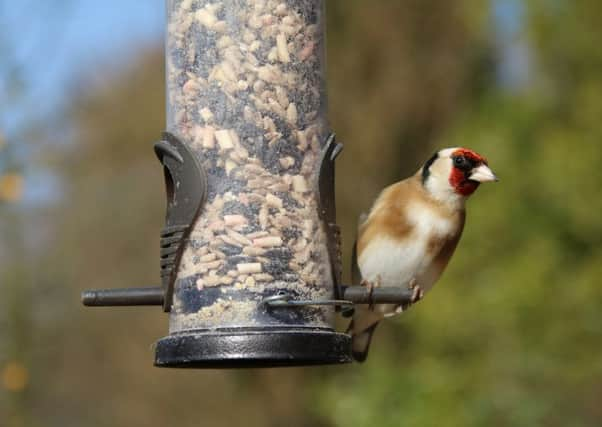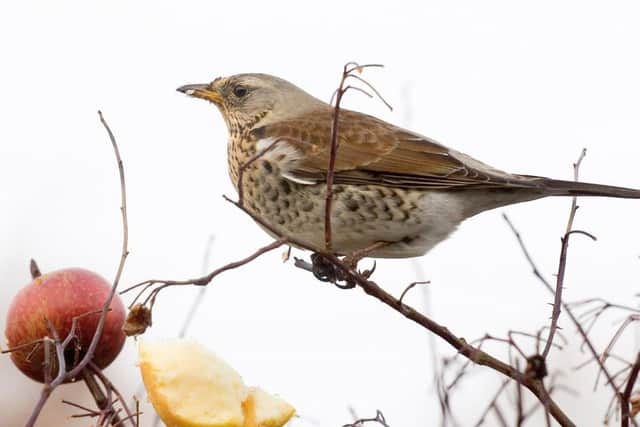GARDENING: Avoid lethal foods for birds in cold weather
This article contains affiliate links. We may earn a small commission on items purchased through this article, but that does not affect our editorial judgement.


Here’s a guide of what to put out and what NOT to give wild birds – some foods are lethal or will cause their feathers to lose their thermal qualities.
Bird seed mixtures: The best contain flaked maize, sunflower seeds and peanut granules. Small seeds, such as millet, attract house sparrows, dunnocks, finches, reed buntings and collared doves, while flaked maize is eaten by blackbirds.
Advertisement
Hide AdAdvertisement
Hide Ad

Tits and greenfinches like peanuts and sunflower seeds. Mixes that contain chunks or whole nuts are suitable for winter feeding only. Pinhead oatmeal is excellent for many birds. Wheat and barley grains are only suitable for pigeons, doves and pheasants, which feed on the ground.
Avoid split peas, beans, dried rice or lentils, as only the large species can eat them dry. If there’s green or pink lumps in a mixture, avoid it - these are dog biscuits, only edible when soaked.
Black sunflower seeds: An excellent year-round food, with a higher oil content than striped ones. Sunflower hearts are a popular no-mess food.
Nyjer seeds: These are small and black with a high oil content but need a special type of seed feeder - loved by goldfinches and siskins.
Advertisement
Hide AdAdvertisement
Hide Ad

Peanuts: rich in fat, they are popular with tits, greenfinches, house sparrows, nuthatches, great spotted woodpeckers and siskins. Crushed or grated nuts attract robins, dunnocks and wrens. Peanuts can be high in the natural toxin aflatoxin, which can kill birds, so buy from a reputable source.
Bird cake and food bars: Fat balls and other fat-based food bars are excellent winter food. Always remove the mesh bag before putting the fat ball out.
Live foods: Mealworms are loved by robins, blue tits and pied wagtails and can be used throughout the year.
Cooking fat: bad for birds, as the meat juices blend with the fat, making it sticky and bad for feathers. It is also a breeding ground for bacteriaand high in salt. Lard and beef suet on their own are fine and as they are pure fat, are not as suitable for bacteria to breed on.
Advertisement
Hide AdAdvertisement
Hide Ad

Polyunsaturated margarines or vegetable oils: Unsuitable, as they need high levels of saturated fat, such as raw suet and lard, to keep warm.
Dog and cat food: Meaty tinned dog and cat food are a substitute for earthworms in summer. Dry biscuits can choke birds.
Milk and coconut: Never give milk - it can result in serious stomach upsets, or even death. Birds can digest fermented dairy products such as cheese, liked by robins, wrens and dunnocks. Give fresh coconut only, in the shell. Never give desiccated coconut.
Rice and cereals: Cooked rice, brown or white (without salt added) is readily taken by all species during severe winter weather. Porridge oats must never be cooked, as they could harden around a bird’s beak.
Advertisement
Hide AdAdvertisement
Hide Ad

Mouldy and stale food: Avoid mouldy food entirely, as some cause respiratory infections.
Keep water in bird baths and ponds unfrozen: Birds need to drink and bathe every day. If you don’t have a pond or bird bath, try an upturned bin lid or plant saucer.
Keep it clean: Dirty feeders and tables can spread diseases. Make sure you clean them regularly and always wash your hands after feeding birds.
JOBS FOR THE WEEKEND
Take note of the most colourful dogwoods (Cornus), Salix and white-stemmed Rubus shrubs when visiting gardens open to the public, or in garden centres, and consider planting them yourself, for a winter display.
Advertisement
Hide AdAdvertisement
Hide AdTidy up leaves from around borders. They can be added to the compost heap, or placed in separate bins to make leafmould. Some leaves, such as plane and sycamore, are slow to break down, and can delay you using your compost if you mix them into the general heap. Leafmould makes an excellent soil improver, and can also be used as a seed-sowing medium.
Watch out for downy mildew and black spot on winter pansies.
Check chrysanthemums regularly for signs of white rust.
This is also a good time to transplant trees and shrubs growing in unsuitable positions. However, if they are more than a couple of years old, you are unlikely to be able to remove an intact enough rootball to ensure the plant’s survival in its new position, and you may be best advised to leave well alone.
Check tree stakes and ties are secure and will withstand the winter weather; ensure that ties are not strangling trunks or branches – they may need loosening.
Advertisement
Hide AdAdvertisement
Hide AdMany pests can overwinter in nooks and crannies in the glasshouse structure (especially in wooden houses), and in the bark of woody houseplants and vines. Mealybugs and scale insect nymphs are commonly found and should be picked off.
Grape vines often have their old bark stripped off before winter, to reduce the number of hiding places for pests like these.
Holly leaf blight is still uncommon, but can be spread in wet weather.
When bringing plants into the house or greenhouse, check them carefully for any pests and diseases they may have picked up in the garden. Unhappy looking plants can always be tipped out of the pot to examine their rootballs for signs of over or under watering, or for soil pests like vine weevil larvae.
Advertisement
Hide AdAdvertisement
Hide AdPut up insulating material such as bubble wrap on the inside of the greenhouse, if not already done.
Avoid walking on lawns on frosty mornings. It can damage the grass and often leads to brown footprint-shaped marks.
Watch your lawn for signs of waterlogging, as the weather gets wetter. You may be able to remedy this with some maintenance now.
GET IN TOUCH
For more on these topics, plus cook what you grow, traditional recipes, North East information, environmental news and more, log on to www.mandycanudigit.com (now smartphone friendly), follow me on Twitter @MandyCanUDigIt or you can like me on Facebook at Mandycanudigit